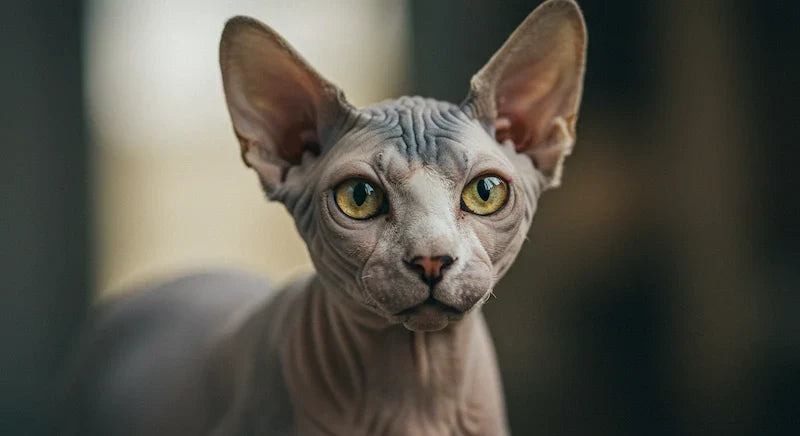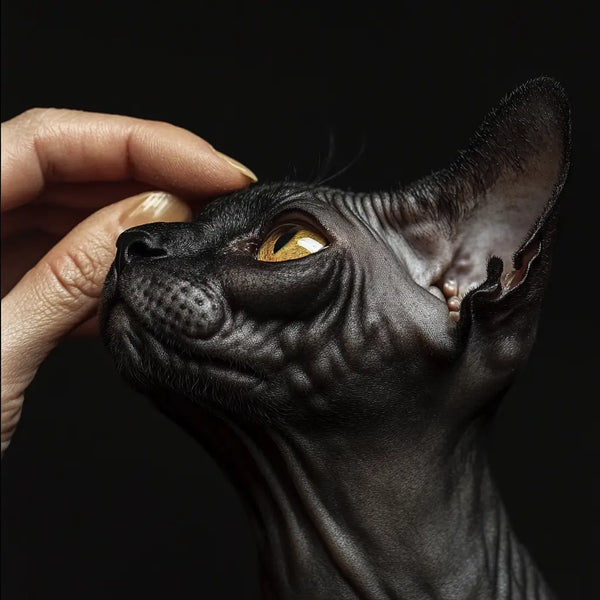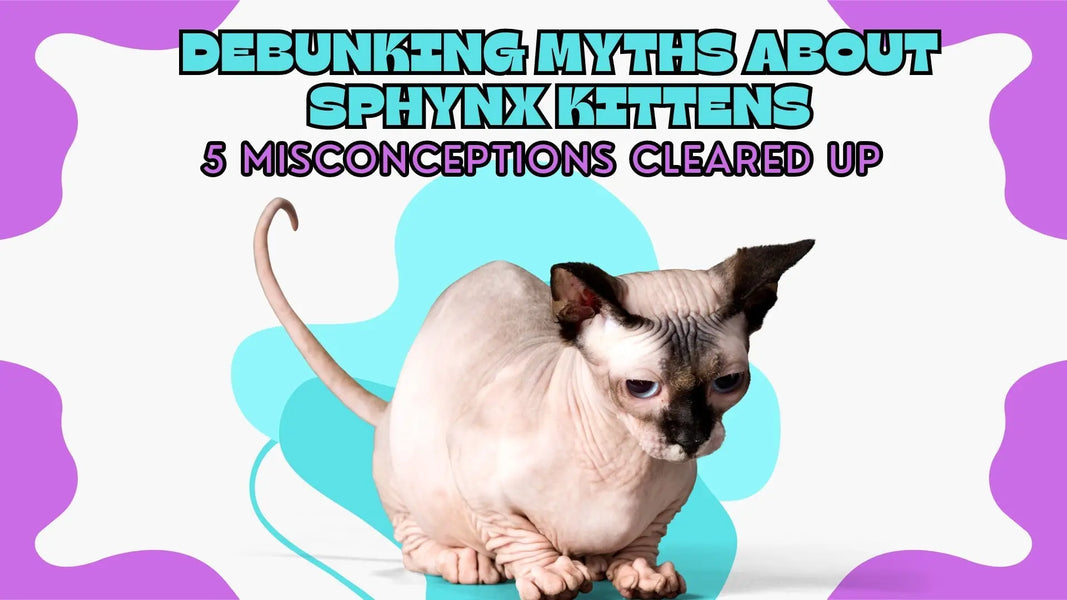Sphynx Cat Skin Care Tips Every Owner Should Know

The Sphynx cat is one of the most distinctive breeds in the world. With their hairless bodies, prominent ears, and loving personalities, they’ve become a favorite among people who want a truly unique feline companion. But beauty comes with responsibility. Unlike other cats, the Sphynx cannot rely on fur to regulate oils, protect against dirt, or shield from the sun. This means sphynx cat skin care is not an optional routine — it’s an essential part of everyday life with this breed.
If you’re new to the Sphynx world, you may wonder: what exactly does it take to keep their skin healthy? How often should they be bathed? What issues are common, and how can you prevent them? This guide covers everything you need to know about sphynx skin care, from understanding their unique needs to practical tips you can implement at home.
Why Sphynx Cats Need Special Skin Care
The defining feature of the Sphynx cat is, of course, its lack of fur. While this makes them look striking and exotic, it also changes how their bodies function compared to other cats.
No Fur Means No Filter
For most cats, fur acts as a natural buffer. It absorbs excess oils, traps dust, and creates a barrier between the skin and the environment. A Sphynx has no such filter. Their skin is directly exposed, which means dirt, sweat, and oil sit on the surface and build up quickly. Owners often notice a fine film of oil on their cat’s body if grooming is skipped even for a few days.
Oil Buildup and Hygiene Challenges
Sebum (the skin’s natural oil) is important for hydration and elasticity. In furry cats, it spreads through the coat and keeps it shiny. In a Sphynx, it remains on the skin and can clog pores, causing acne-like breakouts. This makes routine baths and wipe-downs essential for avoiding discomfort.
Sun and Temperature Sensitivity
Another big challenge is temperature regulation. Sphynx cats can easily get cold in winter or sunburned in summer. While many owners use soft shirts or sweaters to keep them warm, clothing itself can irritate skin if it isn’t washed regularly. Their skin is as delicate as human skin, and without careful attention, it’s easy for irritation to develop.
Simply put, living with a Sphynx means accepting that skin care will be a permanent part of your relationship with your cat. It’s not difficult once you build a routine, but it does take consistency and awareness.

Common Sphynx Cat Skin Issues
Because their skin is so exposed, Sphynx cats face a handful of recurring problems. Most are preventable, but only if you know what to look out for.
Oily Skin and Acne
Clogged pores are the most common issue. Black dots on the chin or belly of your cat are feline acne and are caused by oil clogs. Pimples will also develop if the face isn’t cleaned regularly. Rough scrubbing will cause more damage, just as it will on humans. Clean the face gently and on a regular basis.
Dryness and Flakiness
On the other hand, bathing too frequently strips away too much of the natural oil. Complemented with house dry heat during winter, the hair and the skin end up scaly and itchy. You will notice your cat scratching more and leaving minute white scurf on the floor. Consider this your sign that it's time for bathing less often or for increasing your cat's fluids.
Skin Infections and Rashes
Warmth and moisture from body folds are perfect breeding sites for yeast and bacteria. Red patches, small bumps, or unpleasant odors are the first alarm signals. They can make infections spread and cause intense distress if ignored. Regularly keeping neck, belly, and underarm folds clean avoids these issues.
Recognizing these sphynx cat skin issues helps you prepare ahead of time instead of waiting for problems to develop.

Sphynx Cat Skin Care Routine
Consistency is the secret to successful sphynx skin care. Once you establish a rhythm, your cat will not only look and feel better but also grow accustomed to grooming.
Bathing Frequency and Shampoo
Most Sphynx cats need a bath every 7 to 10 days. Some may require it more often, depending on how oily their skin is. Use a gentle, fragrance-free cat shampoo that removes oil without over-drying. Avoid human shampoos, baby soaps, or anything with harsh chemicals — these can cause irritation or allergic reactions.
-
Fill a sink or tub with lukewarm water.
-
Place a non-slip mat inside to keep your cat comfortable.
-
Apply shampoo gently, focusing on folds and commonly oily areas.
-
Rinse thoroughly — leftover residue can irritate the skin.
Pat the cat dry with a soft towel. Avoid hair dryers, as the heat can dry or burn delicate skin.
Wiping Between Baths
Weekly baths alone aren’t enough. Oil accumulates daily, so between baths, use a soft, damp cloth or unscented pet wipes to clean your cat. Pay special attention to folds, underarms, the chest, and behind the ears. This simple step prevents irritation and keeps your cat comfortable.
Nail and Ear Care
Sphynx cats often get dirt and oil buildup around their nails and inside their ears. Cleaning these areas weekly prevents bacterial growth. Use cotton pads with a vet-approved solution, never cotton swabs, which could damage the ear canal. For time-saving techniques, see DIY Grooming Hacks for Busy Purebred Cat Owners.
Routine grooming may sound like a lot, but it quickly becomes second nature. And for many Sphynx owners, it turns into a bonding ritual that strengthens their relationship with their cat.
Diet and Health Factors Affecting Skin
Skin care isn’t only about external cleaning — it also depends on what’s happening inside your cat’s body. Diet, hydration, and environment all play major roles.
-
High-quality nutrition: A diet rich in protein, omega-3 and omega-6 fatty acids, and vitamins supports skin elasticity and reduces dryness. Low-quality food often leads to dull, irritated skin.
-
Hydration: Encourage water drinking with a fountain. Dehydration is a common cause of flakiness.
-
Supplements: With vet approval, fish oil or other fatty acid supplements can improve skin condition.
Environmental factors matter too. Dry air in winter makes flakiness worse, so consider adding a humidifier in your home. For a broader perspective on breed-specific health needs, Understanding the Unique Needs of Purebred Cats explains why nutrition and environment are so important for purebred breeds like the Sphynx.
Preventing Sphynx Cat Skin Problems
Prevention is far easier than treatment. With a few proactive steps, most sphynx cat skin problems can be avoided entirely.
-
Bedding hygiene: Wash blankets, beds, and favorite spots weekly. Oils easily transfer from their skin to fabrics.
-
Sun and clothing: If your cat spends time near windows, use curtains or shades to limit direct sunlight. Clothing should be soft, breathable, and changed often to prevent irritation.
-
Vet visits: If you notice persistent redness, unusual bumps, or sores that don’t heal, seek veterinary advice early.
For additional grooming techniques, the article Mastering the Art of Grooming offers step-by-step strategies for keeping high-maintenance breeds in top shape.
Step-by-Step Skin Care Checklist
-
Bathe weekly with gentle, fragrance-free shampoo.
-
Wipe skin folds daily with a damp cloth or pet wipes.
-
Clean ears and nails weekly to prevent buildup.
-
Wash bedding and clothes weekly to remove oil.
-
Monitor for redness, bumps, or odors.
-
Provide a diet rich in protein and fatty acids.
-
Maintain indoor humidity to avoid dryness.
-
Limit sun exposure and rotate clean clothing.
-
Consult a vet for persistent issues.
-
Repeat consistently — your cat will thank you.

Conclusion
It is quite an experience raising a Sphynx cat. Their affectionate personalities and theatrical appearances make them one-of-a-kind companions. A part of their appeal comes with the knowledge, however, that there will also be work. Regular sphynx cat skin maintenance — from baths and wipe-downs to wholesome eating and prevention — will keep them comfortable and illness-free.
Recognizing the common sphynx cat issues and taking care of them prior to their exacerbation, not only will problems be prevented, but also an intimate bond with your cat will develop. Under the influence of routine, patience, and appropriate gear, your Sphynx will become the curious, loving companion that it was destined to be.
The more you get to know the Sphynx, the easier it is to see what makes this breed so unique. If you’re curious, you can explore our Sphynx kittens and learn more about their special charm — just remember that caring for their skin is a lifelong act of love.
FAQs About Sphynx Cat Skin Care
Do Sphynx cats smell?
Yes, if their oils aren’t cleaned regularly, they can develop a musky odor. Routine baths and wipes prevent this.
How often should I bathe my Sphynx?
Typically, once a week, but some cats may need more or less depending on their skin.
Can I use baby wipes on my Sphynx?
Only unscented, alcohol-free wipes are safe for pets. Many baby wipes contain chemicals unsuitable for cats.
What’s the best shampoo for a Sphynx cat?
Fragrance-free, hypoallergenic shampoos designed for cats are best. Avoid human shampoos altogether.
Are Sphynx cats hypoallergenic?
They produce less dander than many breeds, but are not truly hypoallergenic. People with severe allergies may still react.





























































Comments(0)